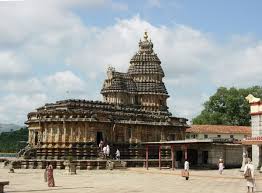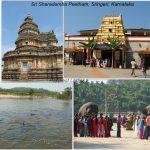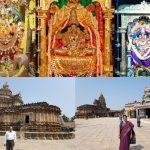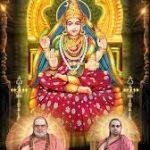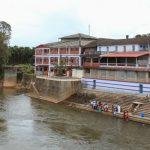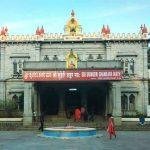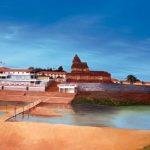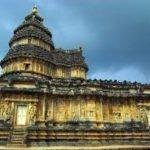Sringeri, Chikkamagaluru, karnataka
| Date built: | – |
|---|---|
| Deity: | – |
| Architectural style: | – |
| Major festivals | – |
| Locale: | – |
| District:: | Chikkamagaluru |
| Address: | – |
| Phone | – |
Sringeri (ಶೃಂಗೇರಿ ) also called Sri Kshetra Shringeri is a hill town and Taluk headquarters located in Chikkamagaluru district in the state of Karnataka, It is the site of the first maṭha (Sringeri Sharada Peetham) established by Adi Shankara, Hindu theologian and exponent of the Advaita Vedanta philosophy, in the 8th century CE It is located on the banks of the river Tungā .The name Sringeri is derived from Rishyashringa-giri, a nearby hill that is believed to have contained the heritage of RishiVibhandaka and his son Rishyashringa. Rishyashringa appears in an episode in the Bala-Kanda of the Ramayana where a story, narrated by Vasishtha, relates how he brought rains to the drought-stricken kingdom of Romapada
Architecture
Legend / Local stories
According to legend, Adi Shankaracharya is said to have selected the site as the place to stay and teach his disciples, because when he was walking by the Tunga river, he saw a cobra with a raised hood, providing shelter from the hot sun, to a frog undergoing labour. Impressed with the place where natural enemies had gone beyond their instincts, he stayed here for twelve years. Adi Shankaracharya also established mathas in the northern (at Jyotirmath, near Badrinath), eastern (at Puri) and western (at Dwaraka) quarters of India.
Jagadguru Sri Adi Shankara Bhagavatpada established the first of the four Amnaya Peethams1 at Sringeri more than twelve centuries ago to foster the sacred tradition of Sanatana Dharma.
Hallowed for all times by Sage Rishyashringa who stayed and performed Tapas here, Sringeri attracted the great Acharya with a remarkable sight.Tradition has it that after the Acharya had dispersed all the non-Vedic creeds prevailing in the country, He was on the look-out for a convenient and holy place where he could establish an institution to spread the truths of Advaita Vedanta. When the Acharya came to Sringeri, he saw an unusual sight on the banks of the Tunga. A cobra was seen spreading out its hood over a frog in labour pains, to give it shadow from the scorching mid-day sun. Struck with the sanctity of the place, which could infuse love between natural adversaries, the Acharya chose this very location to establish His first Math.
The Madhaviya Shankara Digvijayam describes that the Acharya came across many virtuous people at Sringeri and taught them the doctrine of Advaita. He then invoked the Divinity of Knowledge, Goddess Sharada and consecrated an icon of the Goddess. Thus the Peetham He founded at Sringeri in South India for fostering the Vedas and the sacred tradition of Sanatana Dharma came to be known as the Dakshinamnaya Sri Sharada Peetham.
The Acharya appointed his prime disciple, Sri Sureshwaracharya as the first Acharya of the Peetham. Since then, the Peetham has been blessed with an unbroken Guru Parampara, a garland of spiritual masters and Jivanmuktas representing Sri Adi Shankaracharya. The succeeding Acharyas have led a life of such austere penance that it has led disciples to adore in them the radiance of Sri Adi Shankara Himself.
Besides being a centre of spiritual power, Sringeri also came to be known as a great place of traditional learning owing to the presence of Goddess Sharada and the erudition of the Acharyas of the Peetham. The Acharyas were instrumental in bringing forth commentaries on the Vedas and in further expounding the Bhashyas of Sri Adi Shankaracharya. The Acharyas also wrote a number of independent works related to Advaita besides producing a number of hymns underlining their ardent devotion to the non-dual Supreme worshipped in multifarious forms. The Peetham thus came to be regarded as the Vyakhyana Simhasana, The Throne of Transcendental Wisdom. Consequently, the Birudavali hails the Acharya as the occupier of this throne. Many regard Goddess Sharada Herself to be moving in the form of the presiding Acharya of the Peetham.
In the 14th century, royal patronage to the Peetham began with the founding of the famous Vijayanagar empire under the divine guidance of the 12th Acharya, Jagadguru Sri Vidyaranya. The austerity of the Acharya influenced the rulers to such an extent that they began ruling in the name of the Acharya and granted the Peetham the rights over secular administration of the land. At the rulers’ request, the Acharya began conducting a Durbar during the Navaratri festival – an occasion deemed by the rulers to honour their Guru. Subsequently, the Acharya came to be known as the Karnataka Simhasana Prathisthapanacharya and the Peetham became a mighty institution – a Samsthanam and is known to this day as the Jagadguru Shankaracharya Mahasamsthanam, Dakshinamnaya Sri Sharada Peetham at Sringeri. Over the succeeding centuries, a number of empires and rulers including the Mysore Maharajahs Hyder Ali and Tipu Sultan, the Nizam of Hyderabad, the Peshwas and the Keladi rulers and Travancore Rajas were drawn towards the Peetham and respected the Acharya as their Guru.
Photo Gallery
How to Reach:
Contact Details
Official Address

